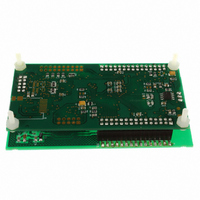STEVAL-ICB002V1 STMicroelectronics, STEVAL-ICB002V1 Datasheet - Page 12

STEVAL-ICB002V1
Manufacturer Part Number
STEVAL-ICB002V1
Description
BOARD EVAL TOUCH STM32/STMPE821
Manufacturer
STMicroelectronics
Datasheets
1.STMPE821QTR.pdf
(50 pages)
2.STEVAL-PCC009V3.pdf
(17 pages)
3.STEVAL-ICB002V1.pdf
(4 pages)
Specifications of STEVAL-ICB002V1
Sensor Type
Touch, Capacitive
Sensing Range
3 Button/Key
Interface
USB
Voltage - Supply
3.3V
Embedded
Yes, MCU, 32-Bit
Utilized Ic / Part
STMPE821
Silicon Manufacturer
STMicroelectronics
Kit Contents
Board
Features
PWM/GPIO Output, Multiple Touch Detection, Demonstrates Up To 3 Capacitive Touch Keys
Svhc
No SVHC (15-Dec-2010)
For Use With
497-10173 - BOARD EVAL S-TOUCH STM32
Lead Free Status / RoHS Status
Lead free by exemption / RoHS compliant by exemption
Sensitivity
-
Lead Free Status / Rohs Status
Lead free / RoHS Compliant
Other names
497-10167
I2C interface
3
12/50
I
The features that are supported by the I
●
●
●
●
●
●
●
SCL/SDA level must be
Start condition
A Start condition is identified by a falling edge of SDATA while SCLK is stable at high state.
A Start condition must precede any data/command transfer. The device continuously
monitors for a Start condition and will not respond to any transaction unless one is
encountered.
Stop condition
A Stop condition is identified by a rising edge of SDATA while SCLK is stable at high state.
A Stop condition terminates communication between the slave device and bus master. A
read command that is followed by NoAck can be followed by a Stop condition to force the
slave device into idle mode. When the slave device is in idle mode, it is ready to receive the
next I
operation to registers.
Acknowledge bit (ACK)
The acknowledge bit is used to indicate a successful byte transfer. The bus transmitter
releases the SDATA after sending eight bits of data. During the ninth bit, the receiver pulls
the SDATA low to acknowledge the receipt of the eight bits of data. The receiver may leave
the SDATA in high state if it would to not acknowledge the receipt of the data.
Data Input
The device samples the data input on SDATA on the rising edge of the SCLK. The SDATA
signal must be stable during the rising edge of SCLK and the SDATA signal must change
only when SCLK is driven low.
Memory addressing
For the bus master to communicate to the slave device, the bus master must initiate a Start
condition and followed by the slave device address. Accompanying the slave device
address, there is a Read/WRITE bit (R/W). The bit is set to 1 for read and 0 for write
operation.
If a match occurs on the slave device address, the corresponding device gives an
acknowledgement on the SDA during the 9th bit time. If there is no match, it deselects itself
from the bus by not responding to the transaction.
2
C interface
I
Compliant to Philips I
Supports standard (up to 100 kbps) and fast (up to 400 kbps) modes.
7-bit and 10-bit device addressing modes
General call
Start/Restart/Stop
I
2
2
2
C slave device
C address is 0x58 (0xB0/0xB1 for write/read, including the LSB)
C transaction. A Stop condition at the end of a write command stops the write
≤
3.6 V
2
C specification version 2.1
Doc ID 14478 Rev 5
2
C interface are the following ones:
STMPE821












